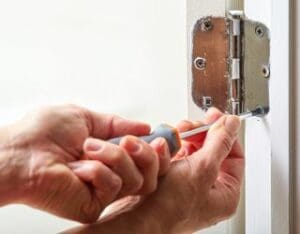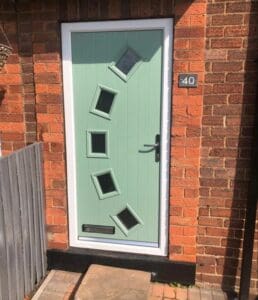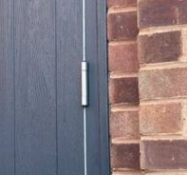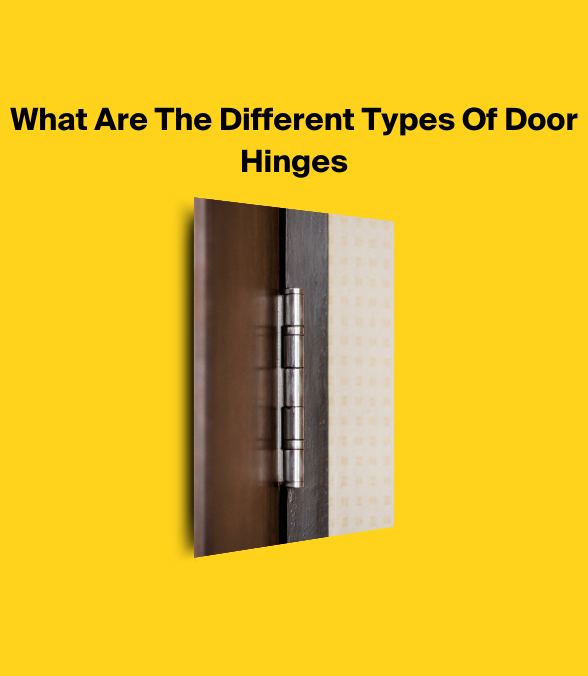Door Hinges Guide - Types and Uses
You’ve probably arrived here looking for different types of hinges for an incomplete project. You either need to replace broken butt hinges, want to upgrade to a better, longer-lasting one or install stronger types of hinges.

A broken or damaged hinge may be a bifold door problem that you can face that needs fixing for your doors to work effectively.
It may be a simple matter of going down to the hardware store and purchasing the cheapest butt hinge.
But, this seldom results in a long-lasting solution.
In this article, we’ll cover the different types of hinges that are available and what they’re used for.
We’ll also show you what to look for in a hinge and how it can make your job easier with better performance.
Considerations for Types of Hinges
Before making your decision to buy a hinge, it’s important to understand what the hinge is required to do.
Door weight
The size and strength of a hinge are determined by how much weight it must support. By consulting a catalogue, you’ll be able to choose one that won’t fail under load.
Some hinges have spacers or washers made of various materials that help cushion the load and allow the door to move more easily.
Range of motion
Depending on your door and where it is located, the hinge you choose must be able to allow for your desired movement.
Some hinges will only open or close in one direction and within a certain number of degrees of movement.
Material
Hinges are manufactured from a great variety of materials. These include stainless steel hinges, steel of various other qualities, brass of over 60 types, bronze, aluminium, as well as plastic.
The material chosen depends on a variety of factors, like required durability, corrosion resistance, as well as aesthetics.
Environment
Do you expect your hinge to resist extreme temperatures?
Are there corrosive substances like salt water that will affect the hinge? Is the hinge being used for indoor or outdoor purposes?
Are there other considerations like extremely heavy use or high loads?
All these questions will help you to determine which material and finish is appropriate for your project.
Aesthetics
Hinges are manufactured to take into account a variety of styles and finishes. So, it's vital that you choose one that matches the overall aesthetic of your project.
Mounting
Different types of hinges can be mounted in various ways. These include surface mounting, concealed mount, or mortise mounts. It's important to choose the right type of hinge for the intended mounting method.
Clearance
The amount of clearance you require between the door and the frame as well as between the door and any other adjacent object will have a bearing on what hinge your choose.
There are a variety of different hinges designed to fit into small spaces as well as provide adjustment to deal with tight tolerances.
Type of swing
Assessing what type of swing you need your hinge to provide can have a significant impact on the outcome of your project. Do you really need 180° of swing or will a smaller degree be sufficient?
By addressing these questions, you’ll avoid buying the wrong hinge.
You will also achieve the desired result with a hinge that lasts a reasonable amount of time and doesn’t require constant adjustment or replacement.
Different Types of Hinges
Let's look at the different types of hinges, what they’re used for, and their basic installation process.
Here’s a list of the different types of hinges available:
- Butt Hinge
- Ball Bearing Hinge
- Butterfly Hinges
- Flag Hinges
- Bullet or Barrel Hinge
- Flush Hinges
- Knife (Pivot) Hinges
- Living Hinges
- Concealed Hinges
- Overlay Hinges
- Offset Hinges
- Institutional Hinges
- Self-closing Hinges
- Spring-loaded Hinges
- Continuous Hinges or Piano Hinges
- Constant Torque Hinges
- Geared Continuous Hinges
The following list describes the more common hinges you’ll come across and to which applications they are most suited.
Butt Hinges
These are the most common types of hinges and are used for heavy entryway doors such as composite doors and uPVC doors, interior doors, cabinetry, and various pieces of furniture.
A butt hinge is one of the simplest forms of a hinge, as it is made from two plates (or leaves) with screws in each plate.
The plates are held together by a central pin that slides inside the barrel and holds the hinge together. The barrels may be separated by ball bearings or plastic washers that support most of the load.
One half of the butt hinge is attached to the door and the other to the frame, so if you have a composite door hinge you need to adjust then this is likely the type you will encounter.
When you close the door, the leaves and screws are usually not visible, while the barrels holding the pin may be visible from one side.
Properly installed, the butt hinge allows the door to be opened smoothly and swing through at least 90°.
Residential and commercial hinges
These hinges typically are available in many different sizes and strengths as well as being manufactured from a variety of materials. They can also be purchased in a wide variety of hinge styles, finishes and colours.
Used in both commercial and residential buildings, a butt hinge is most commonly used to attach both interior doors and exterior doors as well as for wooden gates.
Hinges are sized according to the load they must support. Smaller hinges are used to support a lightweight interior door in a residential building as it is seldom opened and closed.
It also requires less strength to support the weight.
This is opposed to a heavy commercial door in a factory or workshop that supports a heavy fire-retardant door that is opened and closed many times a day.
Cabinet makers and carpenters
Hinges typically used by cabinet makers or carpenters are smaller. This is because the door on a piece of furniture, a cabinet, and cupboards do not carry a huge load.
They are some of the simplest types of hinges to install, requiring limited tools.
When attaching a butt hinge to wooden frames and doors, a rebate is chiselled into both pieces of material. This is done so that the two metal surfaces can lie flat against each other when the cabinet door is closed.
Depending on the size and weight of the door, you may install three or even four hinges to secure it.
Heavy-duty hinges made of brass or steel with ball bearings between the surfaces can be used to support a heavy, solid cabinet door.
Doors come in a large variety of sizes and materials, from lightweight hollow core to heavy oak, birch, and mahogany. Doors also vary in thickness, which must be taken into account when sizing the hinges.
Ball Bearing Hinges
A ball-bearing hinge is utilised in heavy-duty commercial facilities that impose high loads on heavy entryway doors.
It is worth bearing in mind that heavy loads are not just related to the weight of the door but also to the number of times a day the door is opened or closed.
If the door is used more than twenty-five times per day, then you are best served by installing a heavy-duty ball-bearing hinge.

These hinges have lubricated bearings inside the knuckle of the hinge.
It's so the barrels don’t rub against each other and wear out from the stress of supporting heavy doors.
Spring-Loaded Butt Hinge
Spring-loaded hinges are designed to assist the door when it is being opened or closed.
Self-closing hinges are designed with a spring that helps the door close once it is released from the open position.
Double-action spring hinges operate similarly to pivot hinges except that the action is assisted by the inclusion of springs.
These hinges centre the door automatically and are used in food processing facilities like commercial kitchens.
Flush Hinges
Flush hinges, also known as concealed hinges, come in a variety of designs, but the general theme is the same.
One leaf is slightly smaller than the other and as the door closes, the smaller leaf folds inside the other leaf. The large leaf has a recess cut out to make room for the smaller one to lie flush inside it.
Flush hinges do away with the necessity for cutting a recess or mortice into the door and frame but are only used in low-load applications as they are not as strong as normal butt hinges.
Butterfly Hinges
Butterfly hinges are a type of butt hinge that is used for decorative effects. The leaves of the hinge are cut into elaborate shapes, mimicking the wings of a butterfly, giving the hinge its name.
These hinges are most often found on cabinet doors or furniture where strength is less important than aesthetic appeal.
Rising Butt Hinges
Rising butt hinges are very similar to a standard butt hinge, except that the knuckles are cut in a spiral. This causes the door to lift as it opens.
The door’s weight then causes the door to close as it slides down the bevel barrel. You will usually find these types of hinges in bathroom cubicles where a self-closing function is desirable.
Flag Hinges
Flag hinges are designed to be simple to take apart and are the most common type of hinge for uPVC doors in the UK. They consist of two parts, a male and a female leaf.
The leaves are permanently attached to the pin (flagpole) and the barrel, and once installed, the hinge is held in place by gravity with the male pin being inserted into the female barrel.
When required, the door can be removed by lifting it so that the male leaf disengages from the female leaf.
Offset or Parliament Hinges
Parliament hinges are offset hinges that are designed to allow the door to lie flat against the wall when open.
These offset hinges are usually manufactured out of brass for strength. They need to be able to support the full weight of the door at a distance away from the pivot point of the hinge.
A higher quality offset hinge, or Parliament hinge, has ball bearings or robust plastic inserts in the barrel to provide durability and strength.
Barrel Hinges
Barrel hinges typically appear in woodworking projects such as jewellery boxes or small cabinets.
A barrel hinge can only be used where the loads are light, and the carpenter wishes to hide the hinge completely when the door or lid is closed.
Barrel hinges are installed by drilling a hole for the barrel in the frame and the cabinet doors. When the lid closes, the leaves disappear inside the barrels.
Knife Hinge
These hinges have two points that pivot like a pair of scissors and are attached to the top and bottom edges of the door.
They are called pivot hinges typically because they are not installed in the traditional place on a door but rather along the top and bottom edge.
This offers more strength to support commercial doors that you may find in a restaurant kitchen.
Face Frame Hinges
Designed specifically for cabinets that incorporate a face frame, this offset door hinge attaches to the 1-1/2” to 2” frame attached to the front of a cabinet.
They are also referred to as semi-concealed hinges and are popular in the USA.
The Continuous Hinge (Piano Hinges)
You will see continuous hinges on pianos (hence the name "piano hinge") as they are perfectly suited for holding long panels of wood together.
A continuous hinge is normally fitted to pieces of furniture or cabinets that require additional support. The two long leaves run the entire length of the door or window panel.
A piano hinge is not suited for heavy doors or ones that are prone to warping. It is usual to lay the hinge along the length of the wood and frame and then mark the screw holes.
This makes for a more accurate fit and once marked, pilot holes are drilled, and the hinge is screwed in place.
Concealed hinges
Concealed hinges (European hinges) are completely hidden when the doors are closed. This makes them perfect for kitchen cupboards, cabinets, and furniture.
The hinge has two adjustment points which allow for very precise positioning of the door once the hinge is installed.
Due to their complex design and less-than-robust construction, these hinges are not suitable for heavy or oversized doors.
Installation is fairly simple as the mounting plate is attached to the inside of the cabinet and the hinge cup is attached to the door.
Once in place, the two pieces snap together. The door hinge is then adjusted so that the door is flush with the cabinet and in line with the other doors or cabinetry.
Corner Hinges
Corner hinges are designed for cabinet doors where there is no partition in the middle. They are usually attached on the inside of the leading edge of the door that is attached to a partition.
Overlay Hinge
Overlay hinges are a type of offset hinge and are used in the construction of cabinets and are selected based on the type of overlay that is desired.
Overlayed doors may be full, partial, or inset. In each case, the overlay hinge must be selected according to the position of the door relative to the edge of the cabinet.
Installing an overlay hinge can be difficult as it requires that you carefully measure the exact position of the door and hinge with very little margin of error.
Even a small miscalculation will result in the finished look being completely ruined.
Strap Hinges
Strap hinges are usually large, robust hinges used in the construction of gates and barn doors. Any application that requires aesthetically pleasing, decorative door hinges can use a strap hinge.
Installing strap hinges is simple and requires that you position the hinge on the door and frame, and mark the position of the screw holes. Then drill pilot holes and screw the strap hinge in place and secure the pin.
Pivot Hinges
A pivot hinge is designed to carry enormous weight and is fitted to the top and bottom of a door.
They don't require a huge amount of effort to open or close and are mostly used for bifolding doors or in commercial settings.
A smaller, lightweight pivot hinge is designed for use in residential cabinetry. They offer carpenters and cabinetmakers a variety of options for concealing the hinge.
If you need to adjust bifold door hinges read our guide here
FAQs
When do you need heavy-duty door hinges?
Standard door hinges are used for applications where the door weighs up to 200 lbs and is opened and closed less than twenty-five times per day.
Doors weighing more than 200 lbs or doors that are opened and shut more than twenty -five times a day should utilise heavy-duty hinges.
What is the strongest type of hinge?

Ball-bearing hinges are considered the strongest hinges and can usually support loads of up to 260 lbs.
What hinges allow full opening?
A pivot hinge or parliament hinge is the ideal hinge to use when you need to allow your door to open fully.
Final Thoughts
As described above, many different hinges are specifically designed to solve problems related to doors and access.
The vast selection can be quite overwhelming at first. But, by using the concepts and explanations above, you should be able to make the right choice for your particular application.
If you're buying a hinge for a very heavy door or one that is open to extreme weather or high usage, it is best to consult an expert before making a costly mistake.









